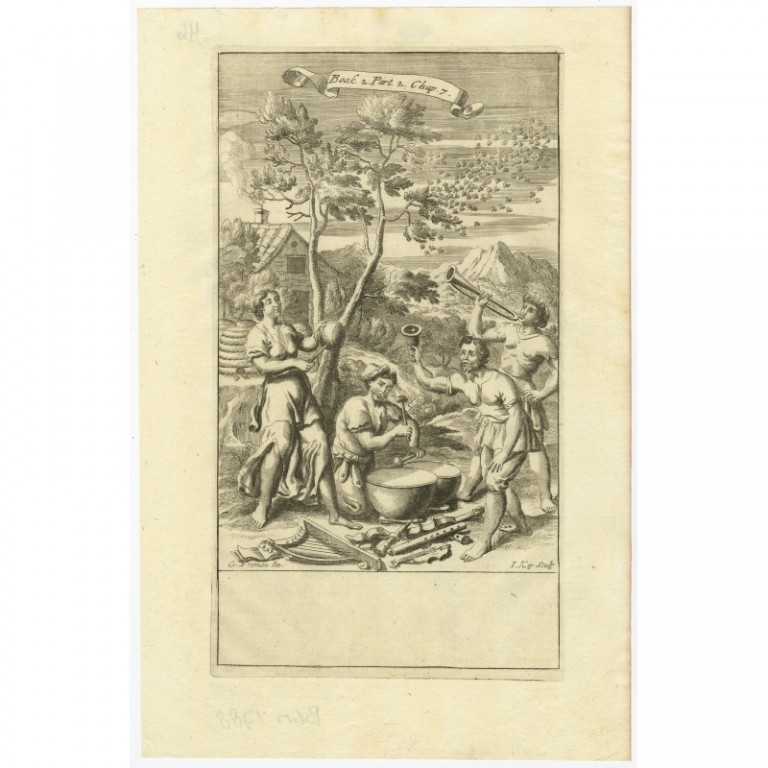FREE
WORLDWIDE
SHIPPING
No products
PCT-62749
Antique Print of Musicians and Instruments by Kip (1694)
- Condition: Very good, given age. General age-related toning and/or occasional minor defects from handling. Please study scan carefully.
- Date: 1686
- Overall size: 21.7 x 33 cm.
Worldwide
shipping
This is a fascinating print by Johannes Kip (1652/53–1722), an accomplished Dutch engraver known for his works illustrating various subjects in philosophy, architecture, and landscapes.
The print depicts a lively musical scene, showing a group of four figures, each engaged with musical instruments. The instruments include trumpets, drums, and various wind and string instruments lying on the ground, with the group seemingly engaged in a rustic or pastoral setting.
Scene Description: - **Foreground**: Four figures (three men and one woman) are engaged in making music. The central figure is playing a large drum, while others play trumpet-like instruments. The woman on the left holds a small vessel or bowl, suggesting that she might be playing a percussion instrument. - **Background**: There is a cottage or farmhouse in the background, a large tree, and a hilly or mountainous landscape in the distance. The sky shows a large cloud formation or possibly a swarm of bees, and the rustic surroundings imply a pastoral theme.
Banner Text: At the top of the print, there is a banner with the text "Book 2. Part 2. Chap. 7," identifying the illustration as belonging to Book 2, Part 2, Chapter 7 of *The Principles of Philosophy* by Anthony Le Grand. This book was first published in 1694 and aimed to explain and popularize René Descartes' philosophy, particularly with a focus on scientific and moral matters.
Engraver: Johannes Kip Johannes Kip is known for detailed and intricate engravings, often illustrating architectural or scientific works. His work frequently appeared in books and atlases of the period. Kip's skill is evident in the precision of the figures, the textures of the foliage, and the dynamic depiction of movement in the scene.
Work Context: *The Principles of Philosophy* by Anthony Le Grand Anthony Le Grand (1629–1699), a French philosopher and follower of Descartes, authored *The Principles of Philosophy* as an effort to explain Cartesian philosophy in a more accessible manner. The work discusses a wide array of topics, from metaphysics and natural philosophy to ethics. This particular illustration from Chapter 7 likely ties into a broader philosophical discussion about the harmony of nature or the arts within a Cartesian framework.
Interesting Aspects: 1. **Philosophical Illustration**: The print serves not merely as an illustration of musical activity but possibly as an allegorical representation of harmony, order, and the human interaction with nature, in line with Cartesian thought. 2. **Pastoral Setting**: The pastoral or rustic elements of the scene contrast with the philosophical sophistication of Le Grand's work, making it an intriguing visual metaphor for complex intellectual concepts represented through everyday life. 3. **Johannes Kip's Detailing**: Kip’s fine engraving style, especially the attention to details like musical instruments, clothing, and landscape features, reflects the artistry and technical prowess of late 17th-century printmaking. This engraving exemplifies the integration of visual arts into philosophical and scientific texts during the Enlightenment, where images played a critical role in interpreting and disseminating complex ideas. The print is from around 1694, the year Le Grand's *Principles of Philosophy* was first published.



